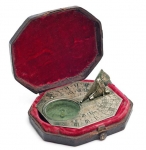Time Telling Instruments > Sundials
17th Century Ivory Diptych Sundial By Leonhart Miller.
Item#: TTS794
SOLD
A 17th Century Ivory Diptych Dial By Leonhart Miller. This is a portable dial measuring 4 1/4 inch long and made from the finest ivory and brass parts. All its surfaces, inside and out, are covered with very beautiful decoration engraved and punched into the ivory and filled with red, black and green colored paints. This sundial was made in 1636 by the famous compass maker Leonhart Miller (Flourished: 1628-49, Died 1653), in Nuremberg Germany. Nuremberg was the leading place for sundial making in the 17th Century. It is signed by the maker on the inner leaf as well as on the outer leaf (‘L [fleur-de-lys mark] M’). It is not known who the sundial was made for, but it is likely that it would have been a rich person. This Ivory diptych dial has 4 main parts (or leafs): (1). Inside the lower leaf is the main horizontal direction dial, with the compass set at one end, and a string gnomon to indicate the actual time. The other end has a time dial in units of Italian hours (0 through 24, beginning at sunset), and Babylonian hours (beginning at sunrise). (2). The inner vertical leaf has two parts. The upper part has a horizontal pin gnomon for measuring the hours of daylight and for indicating the sun’s place in the zodiac. It is marked with nice zodiacal symbols. The lower part has a table of latitudes of various European cities and holes for adjusting the string gnomon for different latitudes. (3). The vertical outer leaf contains the lunar volvelle with brass rotating disk. This dial provides a table in German for converting lunar time to solar time. (4). The horizontal outer leaf is engraved with 16-point compass rose, a brass arrow dial and eight directions in Italian surrounded by decorative floral border. It has a wind vane to help predict weather. Reference: Hester Higton. Sundial. An Illustrated History of Portable Dials. Philip Wilson Pub. London. [2001].
Related Items
-
 Price: $4800.00
Price: $4800.00
Development: Epoch | Design: Luch
Copyright © 1999-2024 Gilai Collectibles. All Rights Reserved





